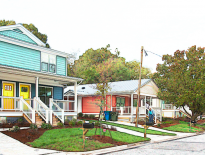Make it Work: How to Talk Sustainability with Stakeholders
Hey, Designers!
You know when you’re in a meeting with a client and they ask, “Why does sustainability matter?” and you’re put on the spot and suddenly can’t remember anything, even your own name? Yeah, I’ve been there! I’ve heard many times that it would be helpful to have talking points in your back pocket for precisely that situation.
When I was a designer, I relied on three strategies to get my client engaged and excited about sustainability. I’m sharing them here, and hope they’ll come in handy the next time you need a quick fact or two to reinforce the value of sustainability in design.

Strategy 1: It’s the Right Thing to Do
First and foremost, designing and constructing sustainable, healthy buildings is the absolute right thing to do. The construction industry (which includes real estate, infrastructure, and industrial buildings) drives 13% of the entire global GDP: and it represents 39% of global carbon emissions annually. It has a ton of impact. Every little thing we do matters.
Talking Point: The negative impacts of the construction industry disproportionately affect communities of color. It’s up to all of us in this industry to design spaces that are healthy in order to create an equitable world.
We have more than 85,000 different chemicals available in the world, and in the USA, only fewer than ten have been banned. The choices we make have affects on our ecosystem, our bodies, and our children’s bodies. John Oliver recently had an amazing segment on PFAS (per- and polyfluoroalkyl substances), which are just one of many types of chemicals that are widely used in building products that are known to cause serious health problems, especially in children. The production and use of these chemicals are especially harmful to people of color. The EPA released a study in 2020 that found that, “people of color are much more likely to live near polluters and breathe polluted air,” and that, “results at national, state, and country scales all indicate that non-whites tend to be burdened disproportionately to whites.” This is an equity issue, one that the building industry must reckon with. Specifying healthy products is not just good for the end-user, it has benefits up the supply chain.
It is our duty as designers to address this fundamental inequality in our industry, and we can do it. The decisions we make in our specifications make huge impacts and have ripple effects. You and your clients can make a huge difference!
Talking Point: Employees who work in “green buildings” are healthier, happier, and more productive.
Numerous studies have shown that employees are happier (less turnover), healthier (take less sick leave), and are more productive (get more done) when they are in a space that has good air quality, less off-gassing, views of nature, and have some control over their lighting and temperature. When employees are happy and productive, it’s good for the bottom line (more money talk below).
Strategy 2: Sustainability, not just for breakfast anymore
I affectionately call this the FOMO (Fear of Missing Out) argument. Sometimes, clients think sustainability is just a buzzword or a trend that will fade so they don’t need to pay attention to it. While that may have been a fair concern back when I started in this industry back in (mumbles year), study after study shows that sustainability is here to stay. Showing clients just how many other people in the world are tackling this issue drives home the point that it’s not just a fad.
Talking Point 1: According to McKinsey, sustainability is one of nine major shifts in the construction industry and they say that, “Companies that can adjust their business models stand to benefit handsomely, while others may struggle to survive.”
In mid-2020, McKinsey released their report titled “The Next Normal in Construction” in which they listed nine industry-disrupting factors they predict will fundamentally shift how the construction industry works. Sustainability is one of these nine shifts. In the report, they write, “While sustainability is an important decision factor already, we are only at the very beginning of an increasingly rapid development.” In fact, when they surveyed executives across the building sector, “more than 75 percent of respondents agree that these shifts are likely to occur, and more than 60 percent believe that they are likely to occur within the next five years.”
Talking Point 2: More than 200 private sector companies have signed the Climate Pledge, and over 10 US states have signed onto the Paris Agreement.
Sometimes clients are worried they’ll be the only ones talking about sustainability and don’t want to stick their neck out. You can assure them that they are in good company. More than 200 companies have pledged to become net-zero carbon by 2040, including Salesforce, Mohawk Group, HP, Selfridges, Procter & Gamble, CBRE, AECOM, Alaska Airlines, Visa, PepsiCo, and more. Your client can align with global brands like these when they set ambitious sustainability goals of their own.
Strategy 3: Money, Money, Money
Sometimes, it really does just come down to money. Fortunately, the stats are in our favor and we are seeing big market shifts that are showing that sustainability means (terrible pun alert!) going green in many ways.
Let’s start by talking about The Market in general, which is seeing a surge in interest and focus on sustainability, climate change, and sustainable products. Then, we’ll dig into some statistics specific to green buildings that you can cap it all off with.
Talking Point: Both consumers and shareholders expect companies to be engaged in combating climate change.
According to the NeilsenIQ group, “90% of millennials are willing to pay more for products that are environmentally friendly, 80% are willing to pay more for products with a social sustainability story.” The market is shifting, and consumers are favoring companies that prioritize sustainable practice. It’s not just consumers, it’s also shareholders. According to BlackRock CEO Larry Fink (BlackRock represents more than $7 trillion in assets), climate change has become, “a defining factor in companies’ long-term success,” and recently announced that BlackRock will begin flagging companies not engaged in getting to net-zero carbon for removal from their investment portfolio.
It’s not just BlackRock: The Economist magazine released a climate and business report in September of 2020 and stated frankly, “Companies that fail to tackle climate change face a backlash.” When it comes to sustainability, there is now a top-down bottom-up shift when it comes to sustainability: consumers and shareholders are holding companies accountable. Wherever your clients exist in this market, you can help them stay on top of this monumental shift!
Talking Point: Building owners and design professionals may be held legally liable if building occupants get sick because of exposure to materials in the building.
As we begin to better understand the direct correlation between the chemicals in building materials and the effects on building users and inhabitants, building owners and designers may start to be held liable, similar to the fire codes and ADA regulations we follow. On August 9 2018, the American Institute of Architects (AIA) wrote a letter to EPA regarding the Asbestos New Use Rule where they stated “historically, architects and other design professionals involved in a construction project strive to avoid liability for hazardous construction materials such as asbestos, lead, PCBs, mercury, etc. Recent lawsuits and regulatory citations have pinned responsibility on design professionals and building owners who seemingly had nothing to do with the exposure that caused, or could cause, a crippling illness.” [our emphasis added.]
Not only that, but the AIA goes on to say “Companies involved in any facet of a demolition, a renovation, or even a current construction project that fail to grasp this salient fact expose themselves to litigation from injured parties as a result of contact (real or perceived) with hazardous materials. As there is no statute of limitations, lawsuits can, and are, being filed decades after project completion.” The old adage of “an ounce of prevention is worth a pound of cure” is definitely true here, and it’s better to be safe than sorry when it comes to the products we specify in buildings.
Talking Point: Green buildings attract talent and can charge higher rent
As we come out of this pandemic and more people shift to working remotely, commercial real estate is going through a fundamental shift. Attracting tenants has become even more cutthroat, and spaces with healthy and sustainable features are faring much better. According to The Business Journal: “When it comes to the future of the office, quality has prevailed. While the office sector across all classes is seeing higher-than-normal vacancy rates, Class B or C space is making up a growing share of what’s vacant in many markets.”
Similarly, companies and building owners are using sustainable features to attract and retain talent. Joseph G. Allen and John D. Macomber of Harvard recently published the book Healthy Buildings: How Indoor Spaces Drive Performance and Productivity, and they project that “offices with the premier health story will get the premium rent and get the tenants, and the offices with a lagging health story will lag” and that “many elite companies already use their building’s efficiency or grandeur to send a signal to customers and workforce talent.”
Talking Point: Stats, stats, stats
Let’s wrap things up with a lightning round of stats you can use when you just need a number to throw out!
- The number of real estate owners reporting greater than 10% increase in the asset value of their property has doubled from 16% in 2012 to 30% in 2018.
- In a survey of 71 different studies about green buildings, researchers found that:
- Rental Income increased on average 6.3%, but could be as high as 23%
- Occupancy Rate Increased on average 6%, or as much as 17%
- Sales Price increased on average 14.8%, or as much as 43%
- In a study of 22 GSA buildings, researchers found that their green buildings (in this case LEED certified) had 20% lower maintenance costs. They also found that “green” retrofits reduce operation cost by almost 10% after only a year.
- Booz/Allen/Hamilton, with USGBC, estimates that green buildings constructed between 2015 and 2018 saved a total of $2.4 Billion in energy costs.
What you can do now:
- Specify healthy products: you can find a list of Red List Free products here to get started!
- Encourage clients to integrate healthy, sustainable products into base specifications and purchasing policies.
- Ask every manufacturer if they have a Declare label, or any type of material ingredient disclosure, and prioritize working with those who do. (I hear from manufacturers every day that say, when designers ask, they listen!)
- Ask your reps if they have a lifecycle assessment and know the carbon, energy, waste, and water impact of their products.
- Specify low carbon products, which you can find using the EC3 tool, the Sustainable Minds database, the Mindful Materials database, or the Ecomedes database.
- Living Product Challenge certified products are net-zero carbon, and have a positive impact on the world!
Learn More:
Interested in hearing more strategies behind “selling” sustainability? Join ILFI and firms MCG Explore Design & MSR Design at our next Living Future Member event: Designers, make it work (sustainably) – to discuss their methods and experiences for incorporating sustainability into every project. Not an ILFI Member? Join today!


